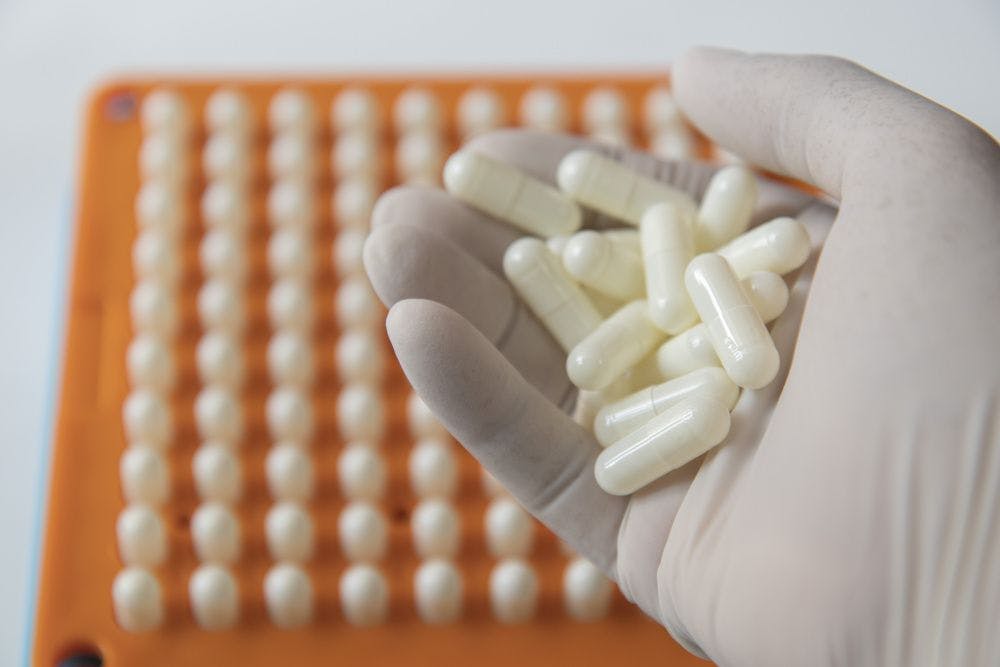Probiotic sales declined in 2020, but probiotics remain a top-seller. How will they fare in 2021? 2021 Ingredient trends to watch for food, drinks, and dietary supplements
Despite a mild sales decline in 2020, probiotics remain a top-selling ingredient across channels. Hear expert predictions about how probiotics' ability to straddle multiple categories, and the growing understanding of microbiome health benefits, will continue to propel probiotics' growth in 2021.
PHOTO © DOUBLE BRAIN - STOCK.ADOBE.COM

Probiotics are still a top seller in the U.S. mainstream and natural supplement channels, racking up sales of $759 million and $126.9 million, respectively, last year based on SPINS (Chicago) data on the 52 weeks ending November 29, 2020. Still, probiotics did experience mild sales decline in 2020, a tumultuous performance year for many product categories. What should we keep an eye on in 2021 when it comes to this well-established category?
Probiotics support a number of health benefits, allowing the ingredient to straddle multiple categories. This year, with the outbreak of the COVID-19 pandemic, the most important reason for consumers to take probiotics may have been to support their immune health.
According to a survey of 3,000 consumers conducted in May 2020 by DuPont Nutrition & Biosciences (Wilmington, DE) in collaboration with the Natural Marketing Institute, probiotic usage among U.S., Italian, and Chinese consumers increased during the pandemic. Results showed that the number of U.S. consumers taking probiotics increased by 66%, amounting to 25% of total supplement users (compared to 15% of total users six months prior). Of these users, the number of U.S. consumers who used probiotics daily or more often increased from 37% to 61% compared to six months prior. Italian consumers saw a 188% increase in probiotic users, to 26% of total supplement users (compared to 9% six months prior) and saw an 83% increase in weekly compliance. Chinese consumers saw a 108% increase in probiotic users, to 48% of total supplement users (compared to 23% six months prior). In the long term, consumers surveyed in both the U.S. and Italy said they expected to continue taking probiotics more often in the ensuing six months compared to the six months prior to the pandemic.
The survey, while limited in scope, demonstrates that there is a global awareness of the ability of probiotics to support immune health and that consumers are taking a proactive approach to their health in the face of the global pandemic.
“On average, the [probiotic] market globally is up by about 6.5%,” says George Paraskevakos, MBA, executive director of the International Probiotics Association (IPA), citing data from Euromonitor International. “The research indicates a relationship between immune and digestive health, and with events of 2020 people are switching to a preventative approach—and that has really helped the industry. If you look at it from a region-specific situation, the U.S. still remains the biggest dietary supplement market for probiotics.” He points out, however, that “China, which has now surpassed Italy for second place, grew a strong 11%-12% annually, whereas the U.S. has slowed down over the past few years.”
The association between digestive health and immune health is not necessarily new, but the concept is now being proliferated to a wider mainstream audience. “The awareness of the association between digestive function and immune function is growing slowly but surely. Commercials and advertisements for OTC products are touting the link, which is resulting in a more educated public,” explains Sam Michini, vice president of marketing and strategy for Deerland Probiotics & Enzymes (Kennesaw, GA). “And as consumers begin to understand that functional digestive status is intertwined with immune performance in times of stress, they find the base concept of two health areas targeted by one product to be very appealing.”
Of course, the potential benefits of probiotic supplementation are not limited to immune health; they extend to brain health, heart health, skin health, women’s health, and more.
“As a whole, the dietary supplement market is evolving towards an increased focus on microbiome health. This can likely be attributed to consumers’ growing understanding of the microbiome-gut-brain axis and the fact that gut health influences all aspects of the body,” says Jennifer Montgomery, AMCAS marketing lead, DuPont Nutrition & Biosciences. “Consumers have become increasingly open to using probiotics for managing health beyond digestive health, and we’ve seen a wide array of functional products targeting cognitive, women’s, skin, antiaging, and metabolic health hit the market.”
The concept of the microbiome-gut-brain axis is an important development in microbiome research and the probiotics category, not only because it deepens our understanding of how the food we eat can influence our physical and emotional well-being but also because it makes sense to consumers. When one considers his or her personal experiences and how stress has manifested in digestive discomfort, it all clicks. “Consumers are realizing how probiotics can help combat negative effects of stress through the microbiome-gut-brain axis, translating to 34% growth of probiotics for boosting mood in the last five years worldwide,” says Montgomery, citing data from Innova Market Insights.
It has been a difficult year for managing mental health, and 2020 supplement sales numbers from SPINS reflect how consumers have relied on supplements to help. The data show 68.6% sales growth in the mainstream brain-health supplements category and 43.8% sales growth in the mainstream sleep-supplements category. Brands would be wise to incorporate probiotics into their brain- or mood-support products. “We’ve also noticed that probiotics in the brain-health space are especially appealing to consumers when paired with other ingredients to maximize end-product benefits,” Montgomery adds.
“We feel the time is ripe to co-formulate and to draw systemic links to emerging condition-based supplement categories,” Michini agrees, pointing to complementary categories such as sleep support, mental health, and mood and stress. “Stress impacts immunity and digestion as well as sleep and mood,” he adds.
In fact, some research has shown that consumers, especially younger consumers, are more likely to purchase products if they contain probiotics, says John Quilter, vice president of global portfolio, proactive health, Kerry (Beloit, WI). “A recent survey [from communications firm Ingredient Communications] found that 50% of U.S. and UK consumers consider ‘contains probiotics’ an appealing statement on food and beverage products,” he explains. “However, this figure rose to 67% among 25- to 34-year-olds. The youngest consumers were also the most likely to consider a product healthy if it contains probiotics (74% of 18- to 24-year-olds compared to 50% of 55- to 64-year-olds).”
Of course, if one is going to make specific claims, it’s important to utilize probiotic strains backed by science for that particular purpose. “When you’re looking for specific benefits, you have to tie the benefits you’re looking for to the specific strain and the research behind it—and not only the strain, but also the dose because the concept of ‘bigger is better’ is not necessarily true,” says Paraskevakos. “If you have a specific benefit you’re looking for, look at what research has been conducted not only in terms of the strain or combination of strains but also what dose was found to be effective for that benefit.”
Branded probiotics such as DuPont’s Howaru line, Deerland’s DE111, and Kerry’s Ganeden BC30 can offer consistent quality and efficacy to products looking to stand out in the marketplace. More than that, branded probiotics offer consumers a recognizable name to look for. The challenge with probiotics is that there are so many strains that it’s often difficult for buyers to understand which they should choose.
“In the probiotics marketplace, the raw-material names (strains) are unwieldy—long words that can be difficult to pronounce followed by seemingly random letters and numbers. In a culture that likes to shorten words—like inspo for inspiration—seeking out probiotics by strain name doesn’t seem likely,” says Michini. “Branded probiotic strains with simple yet relevant names and clinical science to support specific health benefits will win the day with consumers.”
They also create opportunity for manufacturers in growing product categories. For the formulation of brain-health products, for example, DuPont recently launched its proprietary Lacticaseibacillus paracasei Lpc-37 strain called Howaru Calm. “Formulators can consider pairing Howaru Calm with natural relaxants such as ashwagandha and L-theanine to help consumers mitigate the feelings of stress,” says Montgomery. “This allows formulators to develop new probiotic blends that stand out on the shelves while helping consumers cultivate a sense of calm.”
Another area DuPont is targeting is women’s health with its Howaru Feminine Health product containing Lacticaseibacillus rhamnosus HN001 and Lactobacillus acidophilus La-14, which are clinically proven to promote healthy vaginal microbiota. “Women’s health is the biggest growth area right now,” claims Montgomery. “This is mainly because balancing the microbiome is so critical to women’s vaginal and urinary health. Formulators looking to meet this market demand can consider incorporating strains into their products that are formulated exclusively for women’s health and target these specific needs.”
Heart health is another emerging condition for the probiotic category, generating excitement in supplement research and development, says Michini. A recently published study1, for example, found that supplementation with Deerland’s spore-forming probiotic DE111 improved endothelial function in healthy subjects. “It was also shown to be beneficial in the support of healthy cholesterol levels, with a trend in reduction of LDL,” says Michini. “The researchers believe that DE111’s role in supporting cholesterol stems from the probiotic’s ability to increase production of beneficial short-chain fatty acids, such as propionic and butyric acid, which are known to manage healthy cholesterol metabolism by inhibiting the synthesis of liver cholesterol.”
More novel health benefits to consider are skin health and oral care, both of which rely on beneficial bacteria for optimal health. With the potential for ingestible, oral, and topical formats, these two areas provide fertile research and development opportunities, says Michini.
Among the most important innovations in the probiotics space is the ability to incorporate probiotics in shelf-stable foods and beverages. “The biggest game-changer has been the emergence of spore-forming probiotic strains like BC30 (Bacillus coagulans GBI-30, 6086),” says Kerry’s Quilter. “Because they’re highly resistant to extremes of pH, heat, cold, and pressure, they’re a perfect fit for fortification in everyday foods and beverages. As a result, we’re now seeing probiotics in a much wider range of categories—not just the traditional chilled dairy products but also categories like frozen foods and hot drinks.”
The variety of probiotic products available to consumers makes probiotic supplementation accessible and easy while also allowing the industry to target a larger swath of consumers. Besides the benefits sought and the strain used, delivery format is among the most important considerations for consumers when making purchasing decisions. Someone who takes a lot of prescription medicine and is “pill fatigued” may opt for a beverage or stick pack instead, while others may enjoy more-indulgent options such as functional chocolate or gummies either because they have a sweet tooth or because they want their children to get their probiotics. Whichever way consumers take probiotics, it’s positive for the industry.
“With the vast variety of probiotic foods and beverages, consumers are free from one more pill to take,” says Michini. “So not only has compliance increased, but the variety is also attracting many newcomers to trial, and we believe many probiotic newcomers who try some of the products do continue, eventually establishing probiotic consumption as part of their normal supplementation routines.”
And not to worry—there is also still definitively a place for traditional forms. “The fact that consumers can now get the benefits of probiotics in a wide range of everyday food and beverages is hugely exciting,” says Quilter, citing data from Mintel. “However, this trend is expanding choice rather than moving market share from one category to another, and there will always be consumers who prefer supplement formats. Looking at healthy-lifestyle products overall, traditional capsule and tablet formats continue to account for the majority of product launches, with 34% and 25% market share, respectively.”
The bottom line is that the probiotics category will continue to grow, infiltrating multiple product categories in a variety of delivery formats to satisfy the needs of a large cross-section of consumers, providing options for everyone.
Reference
- Trotter RE et al. “Bacillus subtilis DE111 intake may improve blood lipids and endothelial function in healthy adults.” Beneficial Microbes, vol. 11, no. 7 (2020): 621-630
2021 Ingredient Trends to Watch for Food, Drinks, and Dietary Supplements:
Vitamin C
Melatonin
Vitamin D
CBD
Elderberry
Mushrooms
Ashwagandha
Multivitamins
Protein
Probiotics

Polyphenols: The next generation of prebiotics is ready for liftoff
April 21st 2025Explore the prebiotic health benefits of polyphenols and the positive impact they may have on digestive and immune health. Polyphenols, such as those found in European black elderberry, may be an ideal solution for manufacturers trying to break into the digestive health space.

























